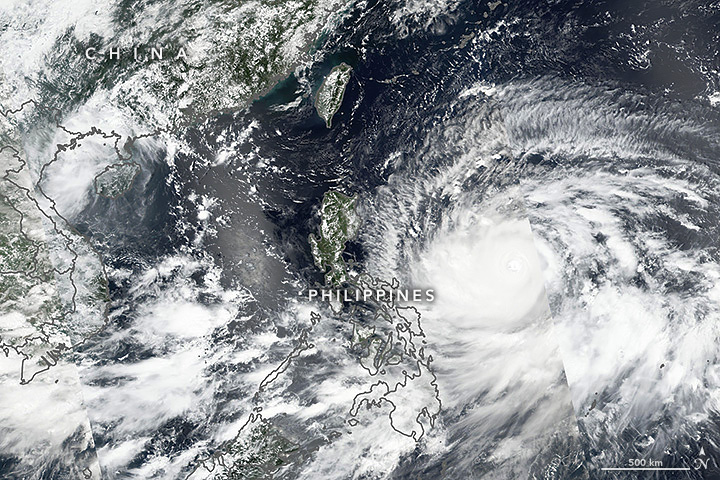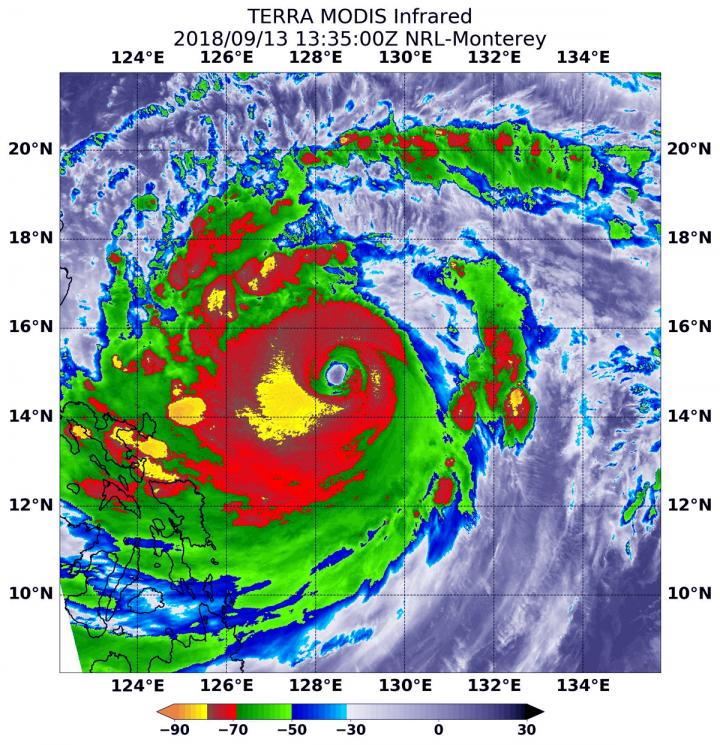Typhoon Mangkhut Bears Down on the Philippines with 165-Mph Winds

As Hurricane Florence dumps rain on the Carolina coasts, another storm is spurring evacuations on the other side of the world.
Typhoon Mangkhut, also known as Typhoon Ompong, is set to batter the Philippines in the early morning of Sept. 15, local time. According to the Philippine Atmospheric, Geophysical and Astronomical Services Administration (PAGASA), the storm surge could reach 19 feet (6 meters) in some areas. [Hurricanes from Above: Images of Nature's Biggest Storms]
The Suomi NPP satellite captured this view of the monster storm on Sept. 13. At the time, the storm's sustained winds were topping out at 165 mph (270 km/h), which would put the storm at a Category 5 on the Saffir-Simpson Hurricane Wind Scale used in the U.S. (Hurricanes are spawned east of the international date line, whereas typhoons develop west of the line.)
Today (Sept. 14), the storm was still blowing with the same sustained wind speeds, along with gusts of up to 200 mph (320 km/h), according to the Joint Typhoon Warning Center in Hawaii. As of 7 p.m. local time (7 a.m. EDT), the storm was centered 162 miles (260 km) northeast of the Philippine municipality of Casiguran on the island of Luzon.
The typhoon is forecast to make landfall on Luzon in the early hours of Saturday, Sept. 15 local time (approximately 5 p.m. EDT on Sept. 14) before heading toward the southern coast of China for a second landfall late on Sept. 16 or early on Sept. 17 local time, according to the PAGASA.
Another satellite, NASA's Aqua satellite, captured an infrared image of Mangkhut on Sept. 13. The satellite's MODIS (Moderate Resolution Imaging Spectroradiometer)instrument uses infrared imagery to detect the temperatures of cloud tops. Around Mangkhut's eye, the data showed towering cloud tops as frigid as minus 80 degrees Fahrenheit (minus 62 degrees Celsius).

The colder the cloud tops are, the higher they are in the atmosphere, which indicates a stronger storm. Storms with cloud tops colder than minus 70 degrees F (minus 57 degrees C) can generate heavy rainfall, according to NASA.
Get the Space.com Newsletter
Breaking space news, the latest updates on rocket launches, skywatching events and more!
Thousands of people have evacuated coastal areas in Luzon ahead of the storm, according to CNN. The island is no stranger to devastating storms. In October 2016, Typhoon Haima made landfall in northern Luzon with Category 4-equivalent winds after a brief period at Category 5 strength. According to the National Disaster Risk Reduction and Management Council, Haima forced the evacuation of nearly 160,000 people and damaged more than 90,000 homes. Nineteen deaths were attributed to the storm, mostly the result of rain-triggered landslides.
Original article on Live Science.
Join our Space Forums to keep talking space on the latest missions, night sky and more! And if you have a news tip, correction or comment, let us know at: community@space.com.

Stephanie Pappas is a contributing writer for Space.com sister site Live Science, covering topics ranging from geoscience to archaeology to the human brain and behavior. She was previously a senior writer for Live Science but is now a freelancer based in Denver, Colorado, and regularly contributes to Scientific American and The Monitor, the monthly magazine of the American Psychological Association. Stephanie received a bachelor's degree in psychology from the University of South Carolina and a graduate certificate in science communication from the University of California, Santa Cruz.











